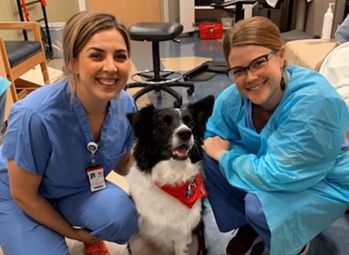What, Specifically, Will You and Your Animal Have to Do During the Test?
Essentials: You must pass all these skill-test items to qualify:
- Your dog must be accepting of a friendly stranger and be willing to sit politely for petting. Must also be clean, healthy and well-groomed.
- Your dog must be willing to go “out for a walk†with you on a loose lead–no pulling or dragging! Then you must both walk through a crowd, also on a loose leash, and be subjected to several visual and noise distractions without your dog panicking, becoming aggressive or too submissive.
- Basic obedience: your dog will have to do a sit, a down, a stay-in-place, and a come-when-called. It must be able to meet a neutral dog without overreacting.
Aptitudes: You may score not ready on no more than three of these and still pass:
Generally, these items relate to people, equipment and situations that you and your animal may encounter while doing therapy visits. Your dog must not object to a thorough, all-over handling by a stranger (fingers in mouth, on tail, feet, etc.), a restraining hug, a staggering, gesturing individual, angry yelling going on, crowded petting, wheelchairs, walkers, etc. Your dog must also be willing to be held by a stranger for two minutes while you disappear. This test grades for overall sociability and observes carefully how must your dog is enjoying this sort of activity. We do not want to try to do good in the world if it means making our animal companions miserable.
These test items are primarily for dogs. If you have some other animal, there will be some variation in the procedures to accommodate species differences.
You may have questions after reading this information. Please feel free to contact us and ask for more detailed responses if you are unsure about what you have read above.
Thanks for your interest! Animal-assisted therapy is an idea whose time has come, and if you and your companion animal decide to join us in doing this work, you will have much joy ahead of you.

